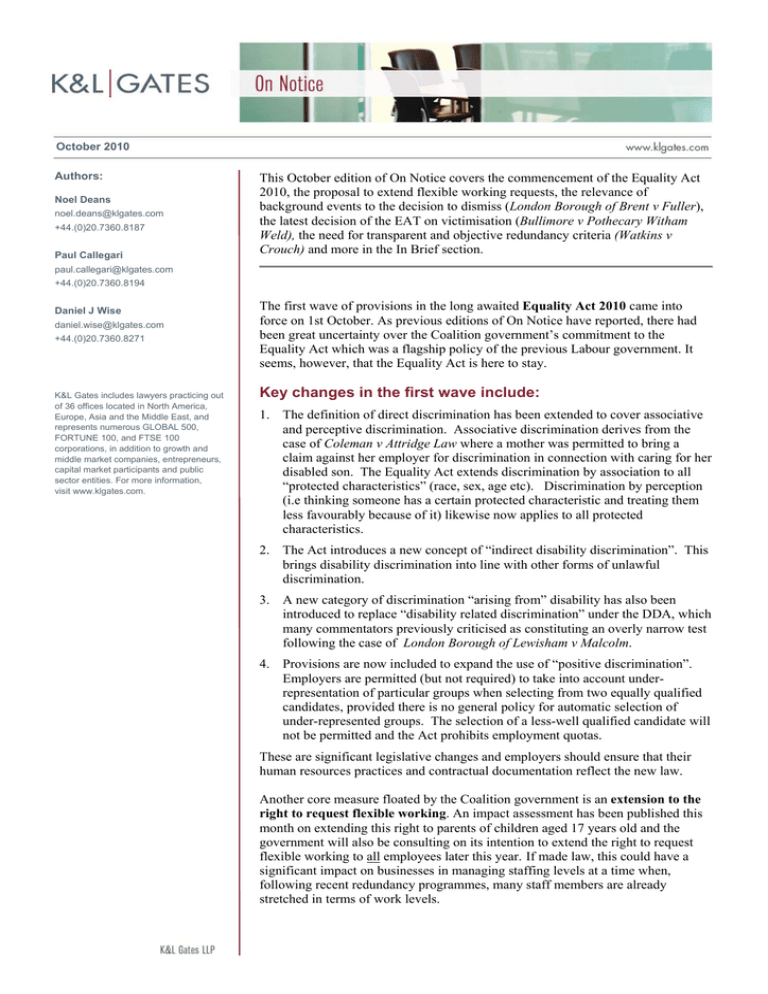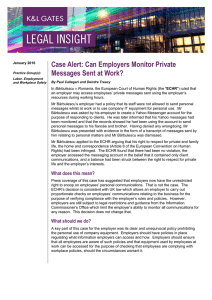Document 13861242
advertisement

October 2010 Authors: Noel Deans noel.deans@klgates.com +44.(0)20.7360.8187 Paul Callegari This October edition of On Notice covers the commencement of the Equality Act 2010, the proposal to extend flexible working requests, the relevance of background events to the decision to dismiss (London Borough of Brent v Fuller), the latest decision of the EAT on victimisation (Bullimore v Pothecary Witham Weld), the need for transparent and objective redundancy criteria (Watkins v Crouch) and more in the In Brief section. paul.callegari@klgates.com +44.(0)20.7360.8194 Daniel J Wise daniel.wise@klgates.com +44.(0)20.7360.8271 K&L Gates includes lawyers practicing out of 36 offices located in North America, Europe, Asia and the Middle East, and represents numerous GLOBAL 500, FORTUNE 100, and FTSE 100 corporations, in addition to growth and middle market companies, entrepreneurs, capital market participants and public sector entities. For more information, visit www.klgates.com. The first wave of provisions in the long awaited Equality Act 2010 came into force on 1st October. As previous editions of On Notice have reported, there had been great uncertainty over the Coalition government’s commitment to the Equality Act which was a flagship policy of the previous Labour government. It seems, however, that the Equality Act is here to stay. Key changes in the first wave include: 1. The definition of direct discrimination has been extended to cover associative and perceptive discrimination. Associative discrimination derives from the case of Coleman v Attridge Law where a mother was permitted to bring a claim against her employer for discrimination in connection with caring for her disabled son. The Equality Act extends discrimination by association to all “protected characteristics” (race, sex, age etc). Discrimination by perception (i.e thinking someone has a certain protected characteristic and treating them less favourably because of it) likewise now applies to all protected characteristics. 2. The Act introduces a new concept of “indirect disability discrimination”. This brings disability discrimination into line with other forms of unlawful discrimination. 3. A new category of discrimination “arising from” disability has also been introduced to replace “disability related discrimination” under the DDA, which many commentators previously criticised as constituting an overly narrow test following the case of London Borough of Lewisham v Malcolm. 4. Provisions are now included to expand the use of “positive discrimination”. Employers are permitted (but not required) to take into account underrepresentation of particular groups when selecting from two equally qualified candidates, provided there is no general policy for automatic selection of under-represented groups. The selection of a less-well qualified candidate will not be permitted and the Act prohibits employment quotas. These are significant legislative changes and employers should ensure that their human resources practices and contractual documentation reflect the new law. Another core measure floated by the Coalition government is an extension to the right to request flexible working. An impact assessment has been published this month on extending this right to parents of children aged 17 years old and the government will also be consulting on its intention to extend the right to request flexible working to all employees later this year. If made law, this could have a significant impact on businesses in managing staffing levels at a time when, following recent redundancy programmes, many staff members are already stretched in terms of work levels. On Notice The EAT decision in London Borough of Brent v Fuller has offered a welcome reminder to Tribunals that employers should be given reasonable discretion in making decisions around dismissals in the context of a disciplinary process. Mrs Fuller was a teacher at a community special school which taught children with emotional and social difficulties. Following an incident in October in which Mrs Fuller interfered with the behavioural management of a pupil, she was dismissed for gross misconduct. The employer took into account a previous similar incident in May for which Mrs Fuller had received a verbal warning. The EAT, disagreeing with the employment tribunal, found for the employer. In passing judgment, the EAT stated that it was wrong to criticise the employer for relying on the May incident. Whilst Mrs Fuller had not been formally reprimanded for that incident, it was part of the background to the current disciplinary issue because it caused Mrs Fuller to be as aware that she was wrong to interfere with behavioural restraint. The May incident was relevant to the October incident and the employer had rightly considered it as part of its reason to dismiss. This case is a timely reminder that an employer’s decision to dismiss can only be impugned if it falls outside the range of reasonable responses. The decision also protects the employer’s right to have regard to previous informal incidents when considering whether to dismiss for a disciplinary offence. In the May edition of On Notice we reported on the EAT decision of Bullimore v Pothecary Witham Weld Solicitors and another which confirmed that the burden of proof was reversed in cases of victimisation on grounds of sex in the same way as in sex discrimination cases. In September the EAT ruled on the separate issue whether Mrs Bullimore could recover loss of earnings from her former employers for the victimisation suffered. The EAT's judgment on this point highlights the risks involved in providing an unfavourable reference. To recap, Miss Bullimore claimed that she had been victimised by PWW (her initial employer) who had sent an unfavourable reference to her new employers, an action allegedly motivated by her bringing her original sex discrimination claim. The new employers subsequently withdrew her job offer and Miss Bullimore presented a claim in the employment tribunal for the earnings she would have received, had the offer not been withdrawn. The tribunal refused Mrs Bullimore’s claim for loss of earnings against PWW on the grounds that the loss was too remote. The EAT disagreed and remitted the case to a tribunal. It recommended that damages for loss of earnings should be apportioned between PWW and the new employer. The EAT also observed that it was foreseeable that the job offer would be withdrawn because the essence of a reference is that it is to be a factor in the decision whether to make a job offer or not. As a matter of policy if a claim did not lie with the future employer for this cause of action it would be undesirable if Mrs Bullimore could not claim loss of earnings against her former employers. Employers should always exercise due care when drafting references for former employees. This case highlights the need for extra caution where that former employee has brought a tribunal claim against the former employer in the past. Watkins v Jeannette Crouch t/a Temple Bird Solicitors The EAT decision in this case provides helpful guidance to employers in how to use criteria scoring in redundancy exercises. Mrs Watkins was a conveyancing secretary for a high street solicitors’ firm. The firm underwent financial difficulties and sought to make 4 positions redundant. In doing so it dismissed Mrs Watkins who, although scoring higher than some of her contemporaries in applying the firm criteria selected for the redundancy scheme, was now not deemed as valuable when considering the "overall business requirements" of the Company. The EAT upheld Mrs Watkins’ complaint and remitted the case to a fresh tribunal to reconsider. The EAT observed that when employers make determinations on the basis of unspecified "overall business requirements" they will be criticised for being too subjective, allowing for unfair decisions to be made as a result. This decision is a useful reminder that redundancy criteria should be objective, transparent and comprehensive. Employers should avoid general criteria which are not October 2010 2 On Notice clearly defined and choose instead specific criteria to apply consistently to all employees. In Brief In West Hertfordshire Hospitals NHS Trust v Evans the EAT has limited Tribunal power in awarding percentage uplifts for procedural failures in dismissal processes. In this case the tribunal awarded a 30% uplift on the claimant’s damages because she had not been warned that dismissal was a possible consequence of her disciplinary meeting. The EAT found this percentage uplift to be excessive, particularly given that the failure to inform Mrs Evans had been a mistake, rather than a deliberate omission, and the employer had attempted to rectify its mistake soon afterwards. Any more than a 10% uplift would be perverse in these circumstances. This case is helpful to employers in that it limits the level of such uplifts being awarded for procedural weaknesses. However, in order to avoid any uplift being awarded when faced with these circumstances employers should restart the process with a carefully drafted letter warning of the possibility of dismissal before moving to the dismissal stage. In Newcastle upon Tyne NHS Hospitals Trust v Armstrong & Others Mrs Armstrong and other cleaners accused their employer of indirect sex discrimination. Whilst the Trust still paid bonuses to porters at the hospital, it had ceased to pay bonuses to the cleaners. The porters were nearly all male whereas the cleaners were almost all female. The Trust sought to argue that the difference was not due to sex but governed by market rates for cleaners. The Court of Appeal rejected this approach. The labour market itself was sexually discriminatory because it was dominated by women who were paid less than men who did jobs of equivalent value. It was up to the Trust to objectively justify the discrimination and they had failed to do so. Accordingly the finding was upheld. Anchorage Austin Beijing Berlin Boston Charlotte Chicago Dallas Dubai Fort Worth Frankfurt Harrisburg Hong Kong London Los Angeles Miami Moscow Newark New York Orange County Palo Alto Paris Pittsburgh Portland Raleigh Research Triangle Park San Diego San Francisco Seattle Shanghai Singapore Spokane/Coeur d’Alene Taipei Tokyo Warsaw Washington, D.C. K&L Gates includes lawyers practicing out of 36 offices located in North America, Europe, Asia and the Middle East, and represents numerous GLOBAL 500, FORTUNE 100, and FTSE 100 corporations, in addition to growth and middle market companies, entrepreneurs, capital market participants and public sector entities. For more information, visit www.klgates.com. K&L Gates is comprised of multiple affiliated entities: a limited liability partnership with the full name K&L Gates LLP qualified in Delaware and maintaining offices throughout the United States, in Berlin and Frankfurt, Germany, in Beijing (K&L Gates LLP Beijing Representative Office), in Dubai, U.A.E., in Shanghai (K&L Gates LLP Shanghai Representative Office), in Tokyo, and in Singapore; a limited liability partnership (also named K&L Gates LLP) incorporated in England and maintaining offices in London and Paris; a Taiwan general partnership (K&L Gates) maintaining an office in Taipei; a Hong Kong general partnership (K&L Gates, Solicitors) maintaining an office in Hong Kong; a Polish limited partnership (K&L Gates Jamka sp.k.) maintaining an office in Warsaw; and a Delaware limited liability company (K&L Gates Holdings, LLC) maintaining an office in Moscow. K&L Gates maintains appropriate registrations in the jurisdictions in which its offices are located. A list of the partners or members in each entity is available for inspection at any K&L Gates office. This publication is for informational purposes and does not contain or convey legal advice. The information herein should not be used or relied upon in regard to any particular facts or circumstances without first consulting a lawyer. ©2010 K&L Gates LLP. All Rights Reserved. October 2010 3





